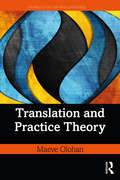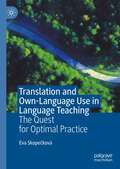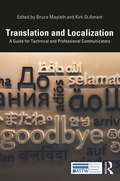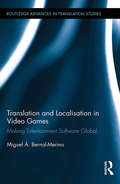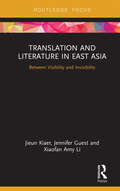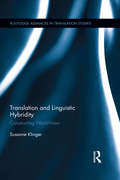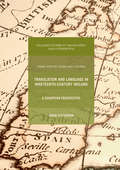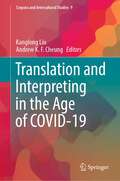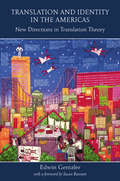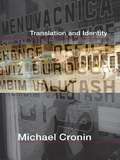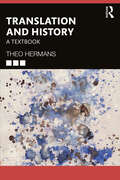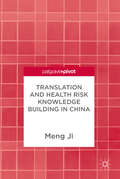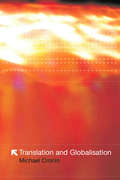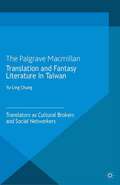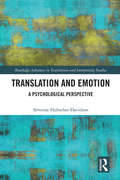- Table View
- List View
Translation and Practice Theory (Translation Theories Explored)
by Maeve OlohanTranslation and Practice Theory is a timely and theoretically innovative study linking professional practice and translation theory, showing the usefulness of a practice-theoretical approach in addressing some of the challenges that the professional world of translation is currently facing, including, for example, the increasing deployment of machine translation. Focusing on the key aspects of translation practices, Olohan provides the reader with an in-depth understanding of how those practices are performed, as translators interact with people, technologies and other material resources in the translation workplace. The practice-theoretical perspective helps to describe and explain the socio-material complexities of present-day commercial translation practice but also offers a productive approach for studies of translation and interpreting practices in other settings and periods. This first book-length exploration of translation through the lens of practice theory is key reading for advanced students and researchers of Translation Theory. It will also be of interest in the area of professional communication within Communication Studies and Applied Linguistics.
Translation and Practice Theory (Translation Theories Explored)
by Maeve OlohanTranslation and Practice Theory is a timely and theoretically innovative study linking professional practice and translation theory, showing the usefulness of a practice-theoretical approach in addressing some of the challenges that the professional world of translation is currently facing, including, for example, the increasing deployment of machine translation. Focusing on the key aspects of translation practices, Olohan provides the reader with an in-depth understanding of how those practices are performed, as translators interact with people, technologies and other material resources in the translation workplace. The practice-theoretical perspective helps to describe and explain the socio-material complexities of present-day commercial translation practice but also offers a productive approach for studies of translation and interpreting practices in other settings and periods. This first book-length exploration of translation through the lens of practice theory is key reading for advanced students and researchers of Translation Theory. It will also be of interest in the area of professional communication within Communication Studies and Applied Linguistics.
Translation and Own-Language Use in Language Teaching: The Quest for Optimal Practice
by Eva SkopečkováThis book reconsiders the role of translation and own-language use in the EFL (English as a Foreign Language) classroom. It shows prospective teachers how to use the learners’ own language and translation optimally. The author surveys current research about the EFL classroom and presents both a theoretical framework and a didactic model for using translation and learners’ mother tongues. This is done through an action research project, assessing the proposed didactic model for optimal translation practice in English Language teaching (OTP in ELT) through its integration into teacher education. The book will be of interest to students and researchers in the areas of Translation Studies and Applied Linguistics (particularly EFL, ESL, TEFL and TESOL), as well as educators and designers of pre-service training programmes for language teachers.
Translation and Localization: A Guide for Technical and Professional Communicators (ATTW Series in Technical and Professional Communication)
by Bruce Maylath Kirk St. AmantDetailed yet accessible, Translation and Localization brings together the research and insights of veteran practicing translators to offer comprehensive guidance for technical communicators. The volume begins with the fundamentals of translation before leading readers through the process of preparing technical documents for translation. It then presents the broader area of localization, again beginning with its key competencies. Concluding chapters examine the state of the field as computers take on more translation and localization work. Featuring real-life scenarios and a broad range of experienced voices, this is an invaluable resource for technical and professional communicators looking to expand into international markets. This book will be of interest to students of ethnic conflict, Asian politics, and security studies.
Translation and Localization: A Guide for Technical and Professional Communicators (ATTW Series in Technical and Professional Communication)
by Bruce Maylath Kirk St. AmantDetailed yet accessible, Translation and Localization brings together the research and insights of veteran practicing translators to offer comprehensive guidance for technical communicators. The volume begins with the fundamentals of translation before leading readers through the process of preparing technical documents for translation. It then presents the broader area of localization, again beginning with its key competencies. Concluding chapters examine the state of the field as computers take on more translation and localization work. Featuring real-life scenarios and a broad range of experienced voices, this is an invaluable resource for technical and professional communicators looking to expand into international markets. This book will be of interest to students of ethnic conflict, Asian politics, and security studies.
Translation and Localisation in Video Games: Making Entertainment Software Global (Routledge Advances in Translation and Interpreting Studies)
by Miguel Á. Bernal-MerinoThis book is a multidisciplinary study of the translation and localisation of video games. It offers a descriptive analysis of the industry – understood as a global phenomenon in entertainment – and aims to explain the norms governing present industry practices, as well as game localisation processes. Additionally, it discusses particular translation issues that are unique to the multichannel nature of video games, in which verbal and nonverbal signs must be cohesively combined with interactivity to achieve maximum playability and immerse players in the game’s virtual world. Although positioned within the theoretical framework of descriptive translation studies, Bernal-Merino incorporates research from audiovisual translation, software localisation, computer assisted translation, comparative literature, and video game production. Moving beyond this framework, Translation and Localisation in Video Games challenges some of the basic tenets of translation studies and proposes changes to established and unsatisfactory processes in the video game and language services industries.
Translation and Localisation in Video Games: Making Entertainment Software Global (Routledge Advances in Translation and Interpreting Studies)
by Miguel Á. Bernal-MerinoThis book is a multidisciplinary study of the translation and localisation of video games. It offers a descriptive analysis of the industry – understood as a global phenomenon in entertainment – and aims to explain the norms governing present industry practices, as well as game localisation processes. Additionally, it discusses particular translation issues that are unique to the multichannel nature of video games, in which verbal and nonverbal signs must be cohesively combined with interactivity to achieve maximum playability and immerse players in the game’s virtual world. Although positioned within the theoretical framework of descriptive translation studies, Bernal-Merino incorporates research from audiovisual translation, software localisation, computer assisted translation, comparative literature, and video game production. Moving beyond this framework, Translation and Localisation in Video Games challenges some of the basic tenets of translation studies and proposes changes to established and unsatisfactory processes in the video game and language services industries.
Translation and Literature in East Asia: Between Visibility and Invisibility
by Jieun Kiaer Jennifer Guest Xiaofan Amy LiTranslation and Literature in East Asia: Between Visibility and Invisibility explores the issues involved in translation between Chinese, Japanese and Korean, as well as from these languages into European languages, with an eye to comparing the cultures of translation within East Asia and tracking some of their complex interrelationships. This book reasserts the need for a paradigm shift in translation theory that looks beyond European languages and furthers existing work in this field by encompassing a wider range of literature and scholarship in East Asia. Translation and Literature in East Asia brings together material dedicated to the theory and practice of translation between and from East Asian languages for the first time.
Translation and Literature in East Asia: Between Visibility and Invisibility (Routledge Studies In East Asian Translation Ser.)
by Jieun Kiaer Jennifer Guest Xiaofan Amy LiTranslation and Literature in East Asia: Between Visibility and Invisibility explores the issues involved in translation between Chinese, Japanese and Korean, as well as from these languages into European languages, with an eye to comparing the cultures of translation within East Asia and tracking some of their complex interrelationships. This book reasserts the need for a paradigm shift in translation theory that looks beyond European languages and furthers existing work in this field by encompassing a wider range of literature and scholarship in East Asia. Translation and Literature in East Asia brings together material dedicated to the theory and practice of translation between and from East Asian languages for the first time.
Translation and Linguistic Hybridity: Constructing World-View (Routledge Advances in Translation and Interpreting Studies)
by Susanne KlingerThis volume outlines a new approach to the study of linguistic hybridity and its translation in cross-cultural writing. By building on concepts from narratology, cognitive poetics, stylistics, and film studies, it explores how linguistic hybridity contributes to the reader’s construction of the textual agents’ world-view and how it can be exploited in order to encourage the reader to empathise with one world-view rather than another and, consequently, how translation shifts in linguistic hybridity can affect the world-view that the reader constructs. Linguistic hybridity is a hallmark of cross-cultural texts such as postcolonial, migrant and travel writing as source and target language come into contact not only during the process of writing these texts, but also often in the (fictional or non-fictional) story-world. Hence, translation is frequently not only the medium, but also the object of representation. By focussing on the relation between medium and object of representation, the book complements existing research that so far has neglected this aspect. The book thus not only contributes to current scholarly debates – within and beyond the discipline of translation studies – concerned with cross-cultural writing and linguistic hybridity, but also adds to the growing body of translation studies research concerned with questions of voice and point of view.
Translation and Linguistic Hybridity: Constructing World-View (Routledge Advances in Translation and Interpreting Studies)
by Susanne KlingerThis volume outlines a new approach to the study of linguistic hybridity and its translation in cross-cultural writing. By building on concepts from narratology, cognitive poetics, stylistics, and film studies, it explores how linguistic hybridity contributes to the reader’s construction of the textual agents’ world-view and how it can be exploited in order to encourage the reader to empathise with one world-view rather than another and, consequently, how translation shifts in linguistic hybridity can affect the world-view that the reader constructs. Linguistic hybridity is a hallmark of cross-cultural texts such as postcolonial, migrant and travel writing as source and target language come into contact not only during the process of writing these texts, but also often in the (fictional or non-fictional) story-world. Hence, translation is frequently not only the medium, but also the object of representation. By focussing on the relation between medium and object of representation, the book complements existing research that so far has neglected this aspect. The book thus not only contributes to current scholarly debates – within and beyond the discipline of translation studies – concerned with cross-cultural writing and linguistic hybridity, but also adds to the growing body of translation studies research concerned with questions of voice and point of view.
Translation and Language in Nineteenth-Century Ireland: A European Perspective (Palgrave Studies in Translating and Interpreting)
by Anne O’connorThis book provides an in-depth study of translation and translators in nineteenth-century Ireland, using translation history to widen our understanding of cultural exchange in the period. It paints a new picture of a transnational Ireland in contact with Europe, offering fresh perspectives on the historical, political and cultural debates of the era. Employing contemporary translation theories and applying them to Ireland’s socio-historical past, the author offers novel insights on a large range of disciplines relating to the country, such as religion, gender, authorship and nationalism. She maps out new ways of understanding the impact of translation in society and re-examines assumptions about the place of language and Europe in nineteenth-century Ireland. By focusing on a period of significant linguistic and societal change, she questions the creative, conflictual and hegemonic energies unleashed by translations. This book will therefore be of interest to those working in Translation Studies, Irish Studies, History, Comparative Literature and Cultural Studies.
Translation and Interpreting in the Age of COVID-19 (Corpora and Intercultural Studies #9)
by Kanglong Liu Andrew K. F. CheungThis book presents the latest developments in translation and interpreting (T&I), which has been at the forefront to face the challenges brought by COVID-19. The contributions in the book contain both quantitative and qualitative empirical studies as well as personal accounts of the impact and opportunities T&I has faced in the global pandemic, covering topics including metaphor translation, delivery of and access to T&I services during COVID-19, renewed perspectives on T&I practice and profession, and technological applications in the T&I classroom. The various themes in the book, through examining the role and many facets of T&I against the backdrop of COVID-19, have demonstrated that T&I as a vital means of intercultural communication is assuming immense importance at a time of uncertainties and disruptions.As one of the books addressing crucial issues of T&I at a time of global crisis, this edited book is of interest to many T&I professionals, researchers, teachers, and students who have been impacted by the pandemic and yet showed a continued interest in T&I and its future emerging practice in the post-pandemic era.
Translation and Identity in the Americas: New Directions in Translation Theory
by Edwin GentzlerTranslation is a highly contested site in the Americas where different groups, often with competing literary or political interests, vie for space and approval. In its survey of these multiple and competing groups and its study of the geographic, socio-political and cultural aspects of translation, Edwin Gentzler’s book demonstrates that the Americas are a fruitful terrain for the field of translation studies. Building on research from a variety of disciplines including cultural studies, linguistics, feminism and ethnic studies and including case studies from Brazil, Canada and the Caribbean, this book shows that translation is one of the primary means by which a culture is constructed: translation in the Americas is less something that happens between separate and distinct cultures and more something that is capable of establishing those very cultures. Using a variety of texts and addressing minority and oppressed groups within cultures, Translation and Identity in the Americas highlights by example the cultural role translation policies play in a discriminatory process: the consequences of which can be social marginalization, loss of identity and psychological trauma. Translation and Identity the Americas will be critical reading for students and scholars of Translation Studies, Comparative Literature and Cultural Studies.
Translation and Identity in the Americas: New Directions in Translation Theory
by Edwin GentzlerTranslation is a highly contested site in the Americas where different groups, often with competing literary or political interests, vie for space and approval. In its survey of these multiple and competing groups and its study of the geographic, socio-political and cultural aspects of translation, Edwin Gentzler’s book demonstrates that the Americas are a fruitful terrain for the field of translation studies. Building on research from a variety of disciplines including cultural studies, linguistics, feminism and ethnic studies and including case studies from Brazil, Canada and the Caribbean, this book shows that translation is one of the primary means by which a culture is constructed: translation in the Americas is less something that happens between separate and distinct cultures and more something that is capable of establishing those very cultures. Using a variety of texts and addressing minority and oppressed groups within cultures, Translation and Identity in the Americas highlights by example the cultural role translation policies play in a discriminatory process: the consequences of which can be social marginalization, loss of identity and psychological trauma. Translation and Identity the Americas will be critical reading for students and scholars of Translation Studies, Comparative Literature and Cultural Studies.
Translation and Identity
by Michael CroninMichael Cronin looks at how translation has played a crucial role in shaping debates about identity, language and cultural survival in the past and in the present. He explores how everything from the impact of migration on the curricula for national literature courses, to the way in which nations wage war in the modern era is bound up with urgent questions of translation and identity. Examining translation practices and experiences across continents to show how translation is an integral part of how cultures are evolving, the volume presents new perspectives on how translation can be a powerful tool in enhancing difference and promoting intercultural dialogue. Drawing on a wide range of materials from official government reports to Shakespearean drama and Hollywood films, Cronin demonstrates how translation is central to any proper understanding of how cultural identity has emerged in human history, and suggests an innovative and positive vision of how translation can be used to deal with one of the most salient issues in an increasingly borderless world.
Translation and Identity
by Michael CroninMichael Cronin looks at how translation has played a crucial role in shaping debates about identity, language and cultural survival in the past and in the present. He explores how everything from the impact of migration on the curricula for national literature courses, to the way in which nations wage war in the modern era is bound up with urgent questions of translation and identity. Examining translation practices and experiences across continents to show how translation is an integral part of how cultures are evolving, the volume presents new perspectives on how translation can be a powerful tool in enhancing difference and promoting intercultural dialogue. Drawing on a wide range of materials from official government reports to Shakespearean drama and Hollywood films, Cronin demonstrates how translation is central to any proper understanding of how cultural identity has emerged in human history, and suggests an innovative and positive vision of how translation can be used to deal with one of the most salient issues in an increasingly borderless world.
Translation and History: A Textbook
by Theo HermansThis concise and accessible textbook is a comprehensive introduction to the key historical aspects of translation. Six chapters cover essential concepts in researching and writing the history of translation and translation as history. Theo Hermans presents and explains fundamental issues and questions in a clear and lively style. He includes numerous examples and case studies and offers suggestions for further reading. Four of the six chapters take their cue from ideas about historiography that are alive among professional historians. They pay attention to the role of narrative, to the emergence of transnational, transcultural, global and entangled history, and to particular fields such as the history of concepts and memory studies. Other topics include microhistory, actor–network theory and book history. With an emphasis on methodology, how to do research in translation history and how to write it up, this is an essential text for all courses on translation history and will be of interest to anyone working in translation theory and methodology.
Translation and History: A Textbook
by Theo HermansThis concise and accessible textbook is a comprehensive introduction to the key historical aspects of translation. Six chapters cover essential concepts in researching and writing the history of translation and translation as history. Theo Hermans presents and explains fundamental issues and questions in a clear and lively style. He includes numerous examples and case studies and offers suggestions for further reading. Four of the six chapters take their cue from ideas about historiography that are alive among professional historians. They pay attention to the role of narrative, to the emergence of transnational, transcultural, global and entangled history, and to particular fields such as the history of concepts and memory studies. Other topics include microhistory, actor–network theory and book history. With an emphasis on methodology, how to do research in translation history and how to write it up, this is an essential text for all courses on translation history and will be of interest to anyone working in translation theory and methodology.
Translation and Health Risk Knowledge Building in China
by Meng JiThis pivot considers the dissemination of public health terms in Chinese scientific research and printed media. Bringing together quantitative and qualitative analysis from corpus linguistics, translation studies, contrastive linguistics to bear on the study of specialised public health translation, it provides key insights into the translation of key public health policy materials produced by authoritative international health agencies like the World Health Organisation (WHO). The study of the acceptance, assimilation and update of translated health risk terms is embedded within corpus translation studies, one of the most dynamic areas of applied translation studies. This study deploys large-scale data bases of scientific publications and printed media materials to trace and analyse the use of translated public health terms and linguistic synonyms by Chinese researchers and media. It also highlights the limits of research investment on critical public health topics such as health financial risks and considers worldwide concerns about the use of accurate and appropriate terminology in specialized fields of knowledge, and the implications for scholarly research, translator training and professional practice.
Translation and Globalization
by Michael CroninTranslation and Globalization is essential reading for anyone with an interest in translation, or a concern for the future of our world's languages and cultures. This is a critical exploration of the ways in which radical changes to the world economy have affected contemporary translation.The Internet, new technology, machine translation and the emergence of a worldwide, multi-million dollar translation industry have dramatically altered the complex relationship between translators, language and power. In this book, Michael Cronin looks at the changing geography of translation practice and offers new ways of understanding the role of the translator in globalized societies and economies. Drawing on examples and case-studies from Europe, Africa, Asia, and the Americas, the author argues that translation is central to debates about language and cultural identity, and shows why consideration of the role of translation and translators is a necessary part of safeguarding and promoting linguistic and cultural diversity.
Translation and Globalization
by Michael CroninTranslation and Globalization is essential reading for anyone with an interest in translation, or a concern for the future of our world's languages and cultures. This is a critical exploration of the ways in which radical changes to the world economy have affected contemporary translation.The Internet, new technology, machine translation and the emergence of a worldwide, multi-million dollar translation industry have dramatically altered the complex relationship between translators, language and power. In this book, Michael Cronin looks at the changing geography of translation practice and offers new ways of understanding the role of the translator in globalized societies and economies. Drawing on examples and case-studies from Europe, Africa, Asia, and the Americas, the author argues that translation is central to debates about language and cultural identity, and shows why consideration of the role of translation and translators is a necessary part of safeguarding and promoting linguistic and cultural diversity.
Translation and Fantasy Literature in Taiwan: Translators as Cultural Brokers and Social Networkers
by Y. ChungThis book examines the rise in popularity of fantasy literature in Taiwan and the crucial but often invisible role that translators have played in making this genre widely available. Topics covered include global fantasy fever, Chinese fantasy, game industry, the social status of translators, and the sociological direction of translations studies.
Translation and Emotion: A Psychological Perspective (Routledge Advances in Translation and Interpreting Studies)
by Séverine Hubscher-DavidsonThis volume tackles one of the most promising and interdisciplinary developments in modern Translation Studies: the psychology of translation. It applies the scientific study of emotion to the study of translation and translators in order to shed light on how emotions can impact decision-making and problem-solving when translating. The book offers a new critical approach to the study of emotion in translation by analysing translators' accounts of their experiences, as well as drawing on a case study of emotional intelligence involving 155 professional translators. The author identifies three distinctive areas where emotions influence translators: emotional material contained in source texts, their own emotions, and the emotions of source and target readers. In order to explore the relevance and influence of emotions in translation, each chapter focuses on a different emotion trait: emotion perception, emotion regulation, and emotion expression.
Translation and Emotion: A Psychological Perspective (Routledge Advances in Translation and Interpreting Studies)
by Séverine Hubscher-DavidsonThis volume tackles one of the most promising and interdisciplinary developments in modern Translation Studies: the psychology of translation. It applies the scientific study of emotion to the study of translation and translators in order to shed light on how emotions can impact decision-making and problem-solving when translating. The book offers a new critical approach to the study of emotion in translation by analysing translators' accounts of their experiences, as well as drawing on a case study of emotional intelligence involving 155 professional translators. The author identifies three distinctive areas where emotions influence translators: emotional material contained in source texts, their own emotions, and the emotions of source and target readers. In order to explore the relevance and influence of emotions in translation, each chapter focuses on a different emotion trait: emotion perception, emotion regulation, and emotion expression.
